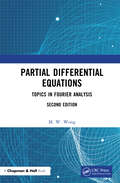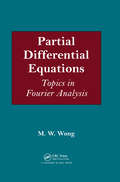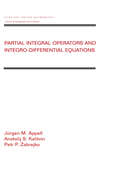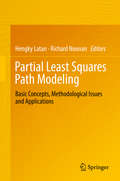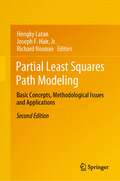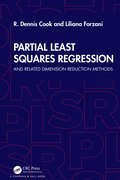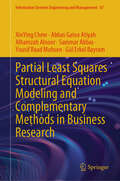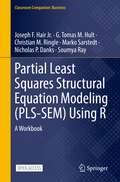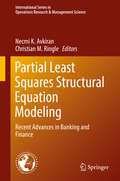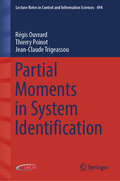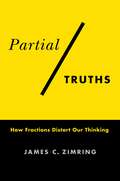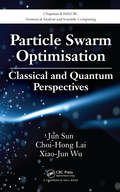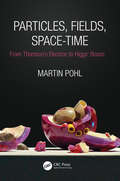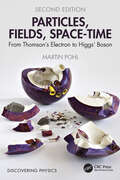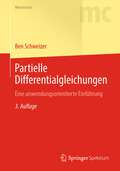- Table View
- List View
Partial Differential Equations: Topics in Fourier Analysis
by M. W. WongPartial Differential Equations: Topics in Fourier Analysis, Second Edition explains how to use the Fourier transform and heuristic methods to obtain significant insight into the solutions of standard PDE models. It shows how this powerful approach is valuable in getting plausible answers that can then be justified by modern analysis. Using Fourier analysis, the text constructs explicit formulas for solving PDEs governed by canonical operators related to the Laplacian on the Euclidean space. After presenting background material, it focuses on: Second-order equations governed by the Laplacian on Rn; the Hermite operator and corresponding equation; and the sub-Laplacian on the Heisenberg group Designed for a one-semester course, this text provides a bridge between the standard PDE course for undergraduate students in science and engineering and the PDE course for graduate students in mathematics who are pursuing a research career in analysis. Through its coverage of fundamental examples of PDEs, the book prepares students for studying more advanced topics such as pseudo-differential operators. It also helps them appreciate PDEs as beautiful structures in analysis, rather than a bunch of isolated ad-hoc techniques. New to the Second Edition Three brand new chapters covering several topics in analysis not explored in the first edition Complete revision of the text to correct errors, remove redundancies, and update outdated material Expanded references and bibliography New and revised exercises.
Partial Differential Equations: Topics in Fourier Analysis
by M.W. WongPartial Differential Equations: Topics in Fourier Analysis explains how to use the Fourier transform and heuristic methods to obtain significant insight into the solutions of standard PDE models. It shows how this powerful approach is valuable in getting plausible answers that can then be justified by modern analysis.Using Fourier analysis, the tex
Partial Identification in Econometrics and Related Topics (Studies in Systems, Decision and Control #531)
by Vladik Kreinovich Nguyen Ngoc Thach Nguyen Duc Trung Doan Thanh HaThis book covers data processing techniques, with economic and financial application being the unifying theme. To make proper investments in economy, the authors need to have a good understanding of the future trends: how will demand change, how will prices change, etc. In general, in science, the usual way to make predictions is: to identify a model that best fits the current dynamics, and to use this model to predict the future behavior. In many practical situations—especially in economics—our past experiences are limited. As a result, the authors can only achieve a partial identification. It is therefore important to be able to make predictions based on such partially identified models—which is the main focus of this book. This book emphasizes partial identification techniques, but it also describes and uses other econometric techniques, ranging from more traditional statistical techniques to more innovative ones such as game-theoretic approach, interval techniques, and machine learning. Applications range from general analysis of GDP growth, stock market, and consumer prices to analysis of specific sectors of economics (credit and banking, energy, health, labor, tourism, international trade) to specific issues affecting economy such as ecology, national culture, government regulations, and the existence of shadow economy. This book shows what has been achieved, but even more important are remaining open problems. The authors hope that this book will: inspire practitioners to learn how to apply state-of-the-art techniques, especially techniques of optimal transport statistics, to economic and financial problems, andinspire researchers to further improve the existing techniques and to come up with new techniques for studying economic and financial phenomena. The authors want to thank all the authors for their contributions and all anonymous referees for their thorough analysis and helpful comments. The publication of this book—and organization of the conference at which these papers were presented—was supported: by the Ho Chi Minh University of Banking (HUB), Vietnam, and by the Vingroup Innovation Foundation (VINIF). The authors thank the leadership and staff of HUB and VINIF for providing crucial support.
Partial Integral Operators and Integro-Differential Equations: Pure and Applied Mathematics (Chapman & Hall/CRC Pure and Applied Mathematics)
by Jürgen M. Appell Anatolij S. Kalitvin Petr P. ZabrejkoA self-contained account of integro-differential equations of the Barbashin type and partial integral operators. It presents the basic theory of Barbashin equations in spaces of continuous or measurable functions, including existence, uniqueness, stability and perturbation results. The theory and applications of partial integral operators and linea
Partial Least Squares Path Modeling
by Hengky Latan Richard NoonanThis edited book presents the recent developments in partial least squares-path modeling (PLS-PM) and provides a comprehensive overview of the current state of the most advanced research related to PLS-PM. The first section of this book emphasizes the basic concepts and extensions of the PLS-PM method. The second section discusses the methodological issues that are the focus of the recent development of the PLS-PM method. The third part discusses the real world application of the PLS-PM method in various disciplines. The contributions from expert authors in the field of PLS focus on topics such as the factor-based PLS-PM, the perfect match between a model and a mode, quantile composite-based path modeling (QC-PM), ordinal consistent partial least squares (OrdPLSc), non-symmetrical composite-based path modeling (NSCPM), modern view for mediation analysis in PLS-PM, a multi-method approach for identifying and treating unobserved heterogeneity, multigroup analysis (PLS-MGA), the assessment of the common method bias, non-metric PLS with categorical indicators, evaluation of the efficiency and accuracy of model misspecification and bootstrap parameter recovery in PLS-PM, CB-SEM, and the Bollen-Stine methods and importance-performance map analysis (IPMA) for nonlinear relationships. This book will be useful for researchers and practitioners interested in the latest advances in PLS-PM as well as master and Ph. D. students in a variety of disciplines using the PLS-PM method for their projects.
Partial Least Squares Path Modeling: Basic Concepts, Methodological Issues and Applications
by Hengky Latan Richard Noonan Joseph F. Hair Jr.Now in its second edition, this edited book presents recent progress and techniques in partial least squares path modeling (PLS-PM), and provides a comprehensive overview of the current state-of-the-art in PLS-PM research. Like the previous edition, the book is divided into three parts: the first part emphasizes the basic concepts and extensions of the PLS-PM method; the second part discusses the methodological issues that have been the focus of recent developments, and the last part deals with real-world applications of the PLS-PM method in various disciplines.This new edition broadens the scope of the first edition and consists of entirely new original contributions, again written by expert authors in the field, on a wide range of topics, including: how to perform quantile composite path modeling with R; the rationale and justification for using PLS-PM in top-tier journals; psychometric properties of three weighting schemes and why PLS-PM is a better fit to mode B; a comprehensive review of PLS software; how to perform out-of-sample predictions with ordinal consistent partial least squares; multicollinearity issues in PLS-PM using ridge regression; theorizing and testing specific indirect effects in PLS and considering their effect size; how to run hierarchical models and available approaches; and how to apply necessary condition analysis (NCA) in PLS-PM.This book will appeal to researchers interested in the latest advances in PLS-PM as well as masters and Ph.D. students in a variety of disciplines who use PLS-PM methods. With clear guidelines on selecting and using PLS-PM, especially those related to composite models, readers will be brought up to date on recent debates in the field.
Partial Least Squares Regression: and Related Dimension Reduction Methods
by R. Dennis Cook Liliana ForzaniPartial least squares (PLS) regression is, at its historical core, a black-box algorithmic method for dimension reduction and prediction based on an underlying linear relationship between a possibly vector-valued response and a number of predictors.Through envelopes, much more has been learned about PLS regression, resulting in a mass of information that allows an envelope bridge that takes PLS regression from a black-box algorithm to a core statistical paradigm based on objective function optimization and, more generally, connects the applied sciences and statistics in the context of PLS. This book focuses on developing this bridge. It also covers uses of PLS outside of linear regression, including discriminant analysis, non-linear regression, generalized linear models and dimension reduction generally.Key Features:• Showcases the first serviceable method for studying high-dimensional regressions.• Provides necessary background on PLS and its origin.• R and Python programs are available for nearly all methods discussed in the book.This book can be used as a reference and as a course supplement at the Master's level in Statistics and beyond. It will be of interest to both statisticians and applied scientists.
Partial Least Squares Structural Equation Modeling and Complementary Methods in Business Research (Information Systems Engineering and Management #67)
by Gül Erkol Bayram Alhamzah Alnoor Yousif Raad Muhsen XinYing Chew Abbas Gatea Atiyah Sammar AbbasThis book offers a practical and accessible guide to Partial Least Squares Structural Equation Modeling (PLS-SEM) in business research, while addressing its limitations by integrating complementary methods such as artificial neural networks (ANN), fuzzy-set qualitative comparative analysis (fsQCA), and multi-criteria decision-making (MCDM). It supports early-career researchers, postgraduate students, and practitioners in navigating complex models, predictive analytics, and latent construct measurement. By focusing on emerging business issues like digital transformation, metaverse, and sustainability, this book delivers clear, applied insights. Readers gain not only foundational knowledge of PLS-SEM but also strategies for enhancing research rigor, prediction, and decision-making using hybrid approaches. This is a timely and essential resource for scholars aiming to advance their methodological toolkit for impactful and actionable business research.
Partial Least Squares Structural Equation Modeling: A Workbook (Classroom Companion: Business)
by G. Tomas Hult Marko Sarstedt Christian M. Ringle Joseph F. Hair Jr. Nicholas P. Danks Soumya RayPartial least squares structural equation modeling (PLS-SEM) has become a standard approach for analyzing complex inter-relationships between observed and latent variables. Researchers appreciate the many advantages of PLS-SEM such as the possibility to estimate very complex models and the method’s flexibility in terms of data requirements and measurement specification. This practical open access guide provides a step-by-step treatment of the major choices in analyzing PLS path models using R, a free software environment for statistical computing, which runs on Windows, macOS, and UNIX computer platforms. Adopting the R software’s SEMinR package, which brings a friendly syntax to creating and estimating structural equation models, each chapter offers a concise overview of relevant topics and metrics, followed by an in-depth description of a case study. Simple instructions give readers the “how-tos” of using SEMinR to obtain solutions and document their results. Rules of thumb in every chapter provide guidance on best practices in the application and interpretation of PLS-SEM.
Partial Least Squares Structural Equation Modeling: Recent Advances in Banking and Finance (International Series in Operations Research & Management Science #267)
by Necmi K. Avkiran Christian M. RingleThis book pulls together robust practices in Partial Least Squares Structural Equation Modeling (PLS-SEM) from other disciplines and shows how they can be used in the area of Banking and Finance. In terms of empirical analysis techniques, Banking and Finance is a conservative discipline. As such, this book will raise awareness of the potential of PLS-SEM for application in various contexts. PLS-SEM is a non-parametric approach designed to maximize explained variance in latent constructs. Latent constructs are directly unobservable phenomena such as customer service quality and managerial competence. Explained variance refers to the extent we can predict, say, customer service quality, by examining other theoretically related latent constructs such as conduct of staff and communication skills. Examples of latent constructs at the microeconomic level include customer service quality, managerial effectiveness, perception of market leadership, etc.; macroeconomic-level latent constructs would be found in contagion of systemic risk from one financial sector to another, herd behavior among fund managers, risk tolerance in financial markets, etc. Behavioral Finance is bound to provide a wealth of opportunities for applying PLS-SEM. The book is designed to expose robust processes in application of PLS-SEM, including use of various software packages and codes, including R. PLS-SEM is already a popular tool in marketing and management information systems used to explain latent constructs. Until now, PLS-SEM has not enjoyed a wide acceptance in Banking and Finance. Based on recent research developments, this book represents the first collection of PLS-SEM applications in Banking and Finance. This book will serve as a reference book for those researchers keen on adopting PLS-SEM to explain latent constructs in Banking and Finance.
Partial Moments in System Identification (Lecture Notes in Control and Information Sciences #494)
by Jean-Claude Trigeassou Régis Ouvrard Thierry PoinotThis book provides a complete round-up of developments concerned with the application of partial moments in system identification and data-driven modelling; it captures the essence of work carried out at the Laboratoire d'Informatique et d'Automatique pour les Systèmes for more than 40 years. The book begins with introductory material, describing both the mathematical tools associated with partial moments and reinitialized partial moments and an example demonstrating their use. The authors then proceed to show how these tools can be used for the identification of continuous-time linear models, discrete-time linear models, continuous-time linear state-space models, linear parameter-varying models and multidimensional models based on partial differential equations. The properties and performances of each of these approaches are presented. The analogy with algebraic approaches is proved, thus opening perspectives for extension to other fields. The text removes some long-standing limitations on the implementation of partial-moment-based tools in system identification. This book is of interest to researchers and postgraduates studying system identification, control theory, applied mathematics and computer science. It is also useful for engineers working on industrial applications of the parametric estimation of mathematical models.
Partial Truths: How Fractions Distort Our Thinking
by James C. ZimringA fast-food chain once tried to compete with McDonald’s quarter-pounder by introducing a third-pound hamburger—only for it to flop when consumers thought a third pound was less than a quarter pound because three is less than four. Separately, a rash of suicides by teenagers who played Dungeons and Dragons caused a panic in parents and the media. They thought D&D was causing teenage suicides—when in fact teenage D&D players died by suicide at a much lower rate than the national average. Errors of this type can be found from antiquity to the present, from the Peloponnesian War to the COVID-19 pandemic. How and why do we keep falling into these traps?James C. Zimring argues that many of the mistakes that the human mind consistently makes boil down to misperceiving fractions. We see slews of statistics that are essentially fractions, such as percentages, probabilities, frequencies, and rates, and we tend to misinterpret them. Sometimes bad actors manipulate us by cherry-picking data or distorting how information is presented; other times, sloppy communicators inadvertently mislead us. In many cases, we fool ourselves and have only our own minds to blame. Zimring also explores the counterintuitive reason that these flaws might benefit us, demonstrating that individual error can be highly advantageous to problem solving by groups. Blending key scientific research in cognitive psychology with accessible real-life examples, Partial Truths helps readers spot the fallacies lurking in everyday information, from politics to the criminal justice system, from religion to science, from business strategies to New Age culture.
Partially Observed Markov Decision Processes
by Vikram KrishnamurthyCovering formulation, algorithms, and structural results, and linking theory to real-world applications in controlled sensing (including social learning, adaptive radars and sequential detection), this book focuses on the conceptual foundations of partially observed Markov decision processes (POMDPs). It emphasizes structural results in stochastic dynamic programming, enabling graduate students and researchers in engineering, operations research, and economics to understand the underlying unifying themes without getting weighed down by mathematical technicalities. Bringing together research from across the literature, the book provides an introduction to nonlinear filtering followed by a systematic development of stochastic dynamic programming, lattice programming and reinforcement learning for POMDPs. Questions addressed in the book include: when does a POMDP have a threshold optimal policy? When are myopic policies optimal? How do local and global decision makers interact in adaptive decision making in multi-agent social learning where there is herding and data incest? And how can sophisticated radars and sensors adapt their sensing in real time?
Partially Ordered Algebraic Systems (Dover Books on Mathematics)
by Laszlo FuchsOriginally published in an important series of books on pure and applied mathematics, this monograph by a distinguished mathematician explores a high-level area in algebra. It constitutes the first systematic summary of research concerning partially ordered groups, semigroups, rings, and fields. The self-contained treatment features numerous problems, complete proofs, a detailed bibliography, and indexes. It presumes some knowledge of abstract algebra, providing necessary background and references where appropriate. This inexpensive edition of a hard-to-find systematic survey will fill a gap in many individual and institutional libraries.
Particle Filters for Random Set Models
by Branko RisticThis book discusses state estimation of stochastic dynamic systems from noisy measurements, specifically sequential Bayesian estimation and nonlinear or stochastic filtering. The class of solutions presented in this book is based on the Monte Carlo statistical method. Although the resulting algorithms, known as particle filters, have been around for more than a decade, the recent theoretical developments of sequential Bayesian estimation in the framework of random set theory have provided new opportunities which are not widely known and are covered in this book. This book is ideal for graduate students, researchers, scientists and engineers interested in Bayesian estimation.
Particle Swarm Optimisation: Classical and Quantum Perspectives (Chapman & Hall/CRC Numerical Analysis and Scientific Computing Series)
by Jun Sun Choi-Hong Lai Xiao-Jun WuAlthough the particle swarm optimisation (PSO) algorithm requires relatively few parameters and is computationally simple and easy to implement, it is not a globally convergent algorithm. In Particle Swarm Optimisation: Classical and Quantum Perspectives, the authors introduce their concept of quantum-behaved particles inspired by quantum mechanics, which leads to the quantum-behaved particle swarm optimisation (QPSO) algorithm. This globally convergent algorithm has fewer parameters, a faster convergence rate, and stronger searchability for complex problems.The book presents the concepts of optimisation problems as well as random search methods for optimisation before discussing the principles of the PSO algorithm. Examples illustrate how the PSO algorithm solves optimisation problems. The authors also analyse the reasons behind the shortcomings of the PSO algorithm.Moving on to the QPSO algorithm, the authors give a thorough overview of the literature on QPSO, describe the fundamental model for the QPSO algorithm, and explore applications of the algorithm to solve typical optimisation problems. They also discuss some advanced theoretical topics, including the behaviour of individual particles, global convergence, computational complexity, convergence rate, and parameter selection. The text closes with coverage of several real-world applications, including inverse problems, optimal design of digital filters, economic dispatch problems, biological multiple sequence alignment, and image processing. MATLAB®, Fortran, and C++ source codes for the main algorithms are provided on an accompanying downloadable resources.Helping you numerically solve optimisation problems, this book focuses on the fundamental principles and applications of PSO and QPSO algorithms. It not only explains how to use the algorithms, but also covers advanced topics that establish the groundwork for understanding.
Particle emission concept and probabilistic consideration of the development of infections in systems: Dynamics from logarithm and exponent in the infection process, percolation effects
by Marcus HellwigThe book describes the possibility of making a probabilistic prognosis, which uses the mean n-day logarithm of case numbers in the past to determine an exponent for a probability density for a prognosis, as well as the particle emission concept, which is derived from contact and distribution rates that increase the exponent of the probable development to the extent that a group of people can be formed.
Particles and Fundamental Interactions
by Sylvie Braibant Maurizio Spurio Giorgio GiacomelliThe book provides theoretical and phenomenological insights on the structure of matter, presenting concepts and features of elementary particle physics and fundamental aspects of nuclear physics. Starting with the basics (nomenclature, classification, acceleration techniques, detection of elementary particles), the properties of fundamental interactions (electromagnetic, weak and strong) are introduced with a mathematical formalism suited to undergraduate students. Some experimental results (the discovery of neutral currents and of the W± and Z0 bosons; the quark structure observed using deep inelastic scattering experiments) show the necessity of an evolution of the formalism. This motivates a more detailed description of the weak and strong interactions, of the Standard Model of the microcosm with its experimental tests, and of the Higgs mechanism. The open problems in the Standard Model of the microcosm and macrocosm are presented at the end of the book. For example, the CP violation currently measured does not explain the matter-antimatter asymmetry of the observable universe; the neutrino oscillations and the estimated amount of cosmological dark matter seem to require new physics beyond the Standard Model. A list of other introductory texts, work reviews and some specialized publications is reported in the bibliography. Translation from the Italian Language Edition "Particelle e interazioni fondamentali" by Sylvie Braibant, Giorgio Giacomelli, and Maurizio Spurio Copyright © Springer-Verlag Italia, 2009 Springer-Verlag Italia is part of Springer Science+Business Media All Rights Reserved
Particles and Fundamental Interactions: Supplements, Problems and Solutions
by Sylvie Braibant Maurizio Spurio Giorgio GiacomelliThis volume is an exercises and solutions manual that complements the book "Particles and Fundamental Interactions" by Sylvie Braibant, Giorgio Giacomelli, and Maurizio Spurio. It aims to give additional intellectual stimulation for students in experimental particle physics. It will be a helpful companion in the preparation of a written examination, but also it provides a means to gaining a deeper understanding of high energy physics. The problems proposed are sometimes true and important research questions, which are described and solved in a step-by-step manner. In addition to the problems and solutions, this book offers fifteen Supplements that give further insight into topical subjects related to particle accelerators, signal and data acquisition systems and computational methods to treat them.
Particles in Flows
by Giovanni P. Galdi Tomáš Bodnár Šárka NečasováThis book aims to face particles in flows from many different, but essentially interconnected sides and points of view. Thus the selection of authors and topics represented in the chapters, ranges from deep mathematical analysis of the associated models, through the techniques of their numerical solution, towards real applications and physical implications. The scope and structure of the book as well as the selection of authors was motivated by the very successful summer course and workshop "Particles in Flows'' that was held in Prague in the August of 2014. This meeting revealed the need for a book dealing with this specific and challenging multidisciplinary subject, i. e. particles in industrial, environmental and biomedical flows and the combination of fluid mechanics, solid body mechanics with various aspects of specific applications.
Particles in the Dark Universe: A Student’s Guide to Particle Physics and Cosmology
by Yann MambriniThis book provides a comprehensive and instructive coverage of particle physics in the early universe, in a logical way. It starts from the thermal history of the universe by investigating some of the main arguments such as Big Bang nucleosynthesis, the cosmic microwave background (CMB) and the inflation, before treating in details the direct and indirect detection of dark matter and then some aspects of the physics of neutrino. Following, it describes possible candidates for dark matter and its interactions.The book is targeted at theoretical physicists who deal with particle physics in the universe, dark matter detection and astrophysical constraints, and at particle physicists who are interested in models of inflation or reheating. This book offers also material for astrophysicists who work with quantum field theory computations. All that is useful to compute any physical process is included: mathematical tables, all the needed functions for the thermodynamics of early universe and Feynman rules. In light of this, this book acts as a crossroad between astrophysics, particle physics and cosmology.
Particles in the Dark Universe: A Student’s Guide to Particle Physics and Cosmology
by Yann MambriniThis second edition of Particles in the Dark Universe has been substantially enhanced with several new chapters that delve into crucial aspects of particle physics in the Universe. These additions encompass the role of primordial black holes in the early universe, tracing their formation to decay, unification theories, a comprehensive historical overview of cosmological models, an extensive examination of the physics of the graviton, and an educational exploration of gravitational phenomena such as Unruh-type or Hawking radiation. Additionally, this edition incorporates 30 new exercises and provides a comprehensive presentation of inflationary models, along with a pedagogical insight into the mechanism of baryogenesis. Structured in a logical sequence, this book offers a thorough and instructional exploration of particle physics within the early universe. It initiates by elucidating the thermal history of the universe, delving into pivotal concepts like Big Bang nucleosynthesis, the cosmic microwave background (CMB), and inflation. Subsequently, it meticulously addresses both direct and indirect detection methods of dark matter, followed by an in-depth analysis of neutrino physics. The book further scrutinizes potential candidates for dark matter and their interactions. Designed for theoretical physicists engaged in particle physics within the universe, dark matter detection, astrophysical constraints, and those interested in models of inflation or reheating, this book also caters to astrophysicists involved in quantum field theory computations. It encompasses all essential elements required for computing various physical processes, providing mathematical tables, necessary thermodynamic functions for the early universe, and Feynman rules. Consequently, this book serves as an intersecting point between astrophysics, particle physics, and cosmology.
Particles, Fields, Space-Time: From Thomson’s Electron to Higgs’ Boson
by Martin PohlCHOICE Highly Recommended 2021Particles, Fields, Space-Time: From Thomson's Electron to Higgs' Boson explores the concepts, ideas, and experimental results that brought us from the discovery of the first elementary particle in the end of the 19th century to the completion of the Standard Model of particle physics in the early 21st century. The book concentrates on disruptive events and unexpected results that fundamentally changed our view of particles and how they move through space-time. It separates the mathematical and technical details from the narrative into focus boxes, so that it remains accessible to non-scientists, yet interesting for those with a scientific background who wish to further their understanding. The text presents and explains experiments and their results wherever appropriate.This book will be of interest to a general audience, but also to students studying particle physics, physics teachers at all levels, and scientists with a recreational curiosity towards the subject.Features Short, comprehensive overview concentrating on major breakthroughs, disruptive ideas, and unexpected results Accessible to all interested in subatomic physics with little prior knowledge required Contains the latest developments in this exciting field
Particles, Fields, Space-Time: From Thomson’s Electron to Higgs’ Boson (Discovering Physics)
by Martin PohlParticles, Fields, Space-Time: From Thomson’s Electron to Higgs’ Boson explores the concepts, ideas, and experimental results that brought us from the discovery of the first elementary particle in the end of the 19th century to the completion of the Standard Model of particle physics in the early 21st century. The book concentrates on disruptive events and unexpected results that fundamentally changed our view of particles and how they move through space-time. It separates the mathematical and technical details from the narrative into focus boxes, so that it remains accessible to non-scientists, yet interesting for those with a scientific background who wish to further their understanding. The text presents and explains experiments and their results wherever appropriate. This book is of interest to a general audience but also to students studying particle physics, physics teachers at all levels, and scientists with a recreational curiosity towards the subject. For this second edition, the complete text has been thoroughly revised. A description of plans for new accelerator facilities has been added, as well as new results on cosmic ray physics, dark matter and dark energy. The usage of natural units has been abandoned in favour of SI units throughout the text.Key Features: Short, comprehensive overview concentrating on major breakthroughs, disruptive ideas, and unexpected results Accessible to all interested in subatomic physics with little prior knowledge required Contains the latest developments in this exciting field
Partielle Differentialgleichungen: Eine anwendungsorientierte Einführung (Masterclass)
by Ben SchweizerDas Buch führt in die Theorie der Partiellen Differentialgleichungen ein, lediglich die Grundvorlesungen der Analysis werden vorausgesetzt. Eine Vielzahl linearer und nichtlinearer Differentialgleichungen wird mit Modellierungsansätzen motiviert und rigoros analysiert. Nach den klassischen linearen Problemen der Potentialtheorie und Wärmeleitung werden insbesondere nichtlineare Probleme aus der Theorie poröser Medien, der Strömungsmechanik und der Festkörpermechanik behandelt. Entlang der Aufgabenstellungen von zunehmender Komplexität werden moderne Methoden und Theorien der Analysis entwickelt.Für die vorliegende 3. Auflage wurde der Text überarbeitet und korrigiert, an vielen Stellen wurden Beweisabläufe optimiert und Motivationstexte eingebaut. An anderen Stellen inhaltlich ausgedünnt und verkürzt, um den Vorlesungsumfang nicht zu sprengen.
